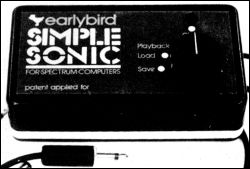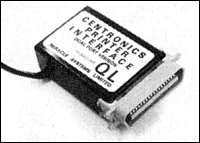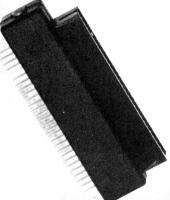| Hardware World |
A FEW YEARS ago, computers like the ZX81 were considered to be viable business machines. These days the QL is overshadowed by the likes of the Atari ST and Commodore Amiga. CST now has four new products which more than redress the balance.
If 128K of memory is not enough, CST now offers an internal upgrade to 512K. For those who find even floppy discs slow and lacking in capacity, its new Winchester hard disc is available in sizes from 10Mb upwards and, according to CST, offers speeds of up to 90 per cent of a RAM disc. Scientific users are catered for with its IEEE interface - the Q-488 - which conforms to the industry standard. Finally, the Q+4 allows you to connect four interfaces into the QL at the same time, and corrects one of the QL bugs into the bargain.
The memory upgrade requires you to send your QL off to CST where they replace the old 64K chips with 256K ones, and a handful of support chips. That, of course, will invalidate your Sinclair warranty but, unlike other similar offers, CST will honour any time left on it. In addition, the upgrade is covered for 90 days.
The obvious advantage when increasing the memory in this way is that the user port on the end of the machine is left free for disc interfaces and the like. It is also the cheapest way, but bear in mind that you now have a 512K machine, whereas adding 512K externally would give 512K plus the 128K already in the machine - 640K in total.
The price of the upgrade is £150 plus VAT which represents good value for money. It is also far more convenient than having half a ton of hardware hanging out from the side of the QL.
The Winchester hard disc is definitely the ultimate mass storage device for a computer - laser discs excepted if and when they finally appear. The unit I was shown had a 10Mb capacity, but CST can supply larger units - anything up to 100Mb.
The drive operates in a similar manner to a floppy disc, on average, about five times faster. In practice, that varies from two to ten times faster depending on the operation being carried out. The transfer rate is roughly 25K bytes per second.
Using the drive is no more difficult than using micro drives. All the usual commands can be transferred to it and run without alteration. With so much storage available the directory can end up reading like War and Peace, so all the commands in CST's floppy interface - October '85 - have been added, including a selective directory.
In order to keep track of all the files you could put on a Winchester, each one is date-stamped every time it is accessed. CST provides a program, called Data Management Utility, which allows you to deal selectively with the files according to the date.
Winchesters tend to be expensive and the CST drives are no exception. The 10Mb unit is a hefty £1,200 plus VAT which compares favourably with Winchesters for other computers. Larger units command larger prices.
The Q-488 conforms to the IEEE-488 standard for connecting peripherals to a computer. Up to 14 peripherals can be connected at any one time and, sockets permitting, you can connect more than one 488. The sort of peripherals you can add range from laboratory and medical instruments to printers, disc drives and modems.
The beauty of the Q-488 is its ease of use. Many other interfaces require you to delve into the operating system to work them, but CST has added a number of SuperBasic extensions which make it very simple. The Q-488 is one of the best reasons for buying a QL. More technical information can be obtained from CST, as can the interface at £195 plus VAT.
Last of CST's new products is the Q+4. That is a metal box which sits under the QL and angles the keyboard towards you. It provides four outlets to plug in interfaces or RAM at the back, and it is supplied with its own QL style power supply. It is connected to the QL via a short flexible cable to the user port, so you gain only three extra sockets.
That is its largest drawback. Although it has a ROM built in which corrects a QDOS bug, so that it can recognise more than one peripheral, and is very well engineered, the price at £170 plus VAT is rather high for what is effectively not very much.
CST Ltd, Hertfordshire.

WHEN THE Spectrum was first launched there was an avalanche of Load/Save and On/Off switches released for it.
The Earlybird Simple Sonic provides the normal Load/Save switching so that you do not have to swap leads, and also has a Playback position. That sends the signal to a DIN socket on the box so that you can plug in your hi-fi: Space Invaders at 40 Watts a channel.
The switch on the front of the box also has a Clear position where, if a button is also pressed, it interrupts the power to the Spectrum to clear the memory. All in all, a simple little device and reasonably priced at £14.99, plus 70 pence p&p.
Early Bird, Lancs.
MIRACLE Systems has brought out two new QL products and announced an upgrade to its RS232 to Centronics Converter - considered by many to be the QL standard.
The Modaptor overcomes the QL's inability to operate with a split baud rate, such as the 1200/75 used by Prestel. It can also cope with 300/300 and 1200/1200 full duplex. Each of those rates are selected by switches on of the Modaptor.

One end of the Modaptor plugs into the SER2 port of the QL with the other end terminating in a 25 pin Din plug. It can plug into any modem which has a similar socket, unfortunately, that excludes modems such as the Prism 1000 and other low cost modems.
The software supplied with the Modaptor - written by QCODE - is in two parts. You can use it to access Prestel and Micronet 800, or to emulate a VT52 terminal which allows access to bulletin boards.
The Prestel software is fairly rudimentary by Brightstar and Q-Comm standards but it works, and it can handle the fancy Micronet graphics.
Other than simply letting you look through the frames on Prestel this part of the software does little else. The VT52 terminal emulation is well written.
A multitude of control codes are available from the keyboard, enough to deal with any eventuality, even down to emulating the VT52 numeric keypad. Most useful, however, is the ability to assign strings to 16 of the keys. Users stuck in MUD will find it particularly helpful.
Overall, the package is a little rough around the edges and not quite up to the standard of other QL modem packages, but it is good value at only £39.
The Double Expander is designed to allow you to plug an interface and additional RAM into the QL at the same time.
Despite its homebrew look the expander works, and at £39 it is the cheapest way to plug two cards in at the same time. Its nearest rival is over twice the price.
Finally, the RS232 to Centronics converter has been altered so that it can be plugged into either SER1 or SER2.
Despite those changes the price of the converter remains at £29.95.
Miracle Systems Ltd, Bristol.

THE NIDD VALLEY Extender Bar and Reset Button is one of the simplest pieces of hardware I have seen for a while.
It just plugs into the back of the Spectrum and extends the connector by roughly three centimeters. That is just enough to allow you to fit add-ons which, due to the case design, will not fit naturally.
As a bonus, there is a button on the side of the extender which gives a reset when pressed. That is better than pulling the power plug as you are less likely to damage such things as microdrive cartridges, and it will not de-program programmable joystick interfaces.
The extender is priced at £4.95 inc.
Nidd Valley Micro Products Ltd, North Yorkshire.
FAST WILL HAVE to be quick off the mark to stem the recent flood of back-up devices for the Spectrum.
The latest of those, the Spec-Mate from AT&Y Computing will back-up a program to tape, microdrive, disc drive - Beta- or Wafadrive at the press of a button, generally irrespective of whatever fancy protection techniques have been used.
As Spec-Mate does not have to be connected to reload the backed-up program, the potential for misuse is high. Hopefully, purchasers will not abuse it, as while backing-up your own programs is a necessity, piracy should be, and with the new copyright laws is being, stamped out.
In terms of ease of use, Spec-Mate falls between Interface III and the Microdriver, the latter being the easiest. Once a program has loaded, a button on the interface is pressed and the program freezes. From there on you have to type blind, that is, apart from the border changing colour there is nothing on the screen to show which keys you have pressed.
Once frozen you have to press a key to denote how the program should be saved, to tape, disc, or to examine the screen. Software houses are getting wise to those sort of devices and sometimes put data on the screen. Examine allows you to remove the colour and reveal any data hidden there.
Spec-Mate needs some of the Spectrum's memory and uses the screen for storage. It allows you to specify which part of the screen it uses which should overcome most protection problems.
Now the program can be saved, with or without a screen display, so that microdrive users can get two programs on one cartridge. You have to type in a filename blind, but once you get used to it the process is reasonably easy.
Spec-Mate is straightforward to use and has the advantage that if you use microdrives and want to change to discs at a later date you can still use it. The price, £39.95 inc seems to be average at the moment.
AT&Y Computing Ltd, London SW9.